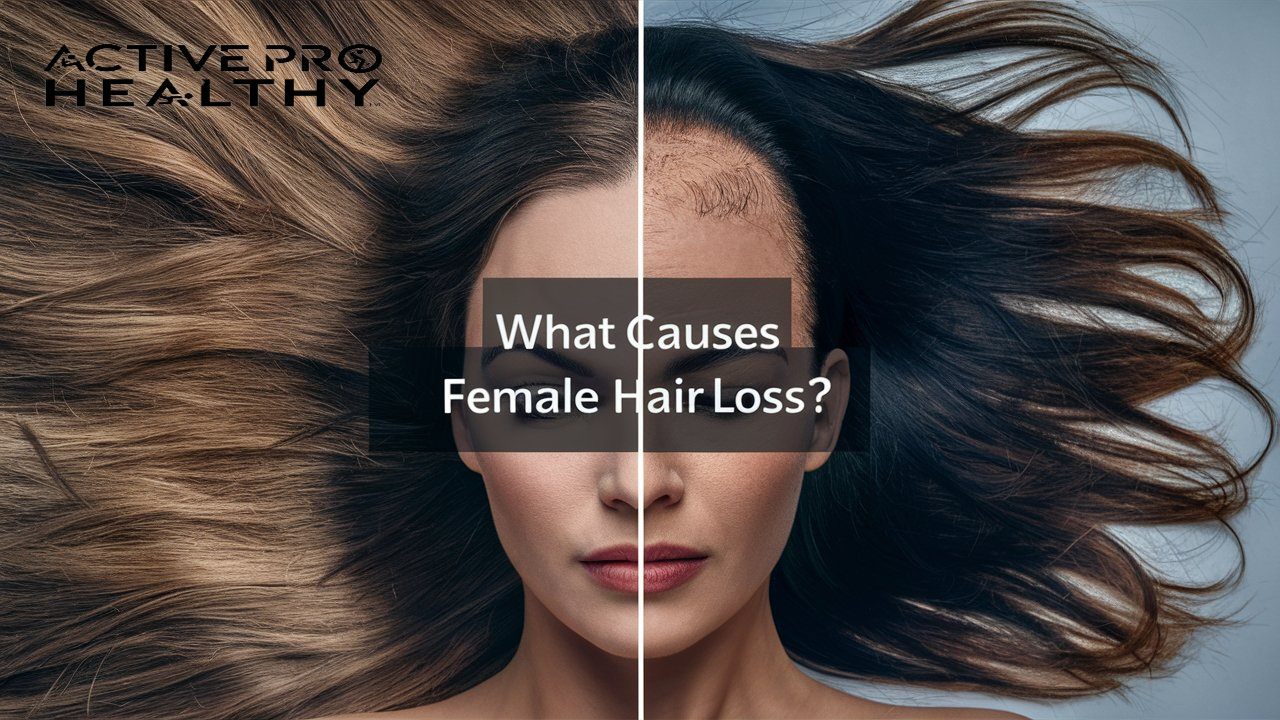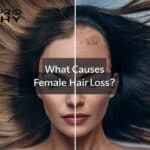Male hair loss is a popular conversation topic, yet so many females suffer in silence as their hair thins or falls out.” Statistics show that fifty percent women between the ages of fifty suffer from short-term baldness. The present blog post reviews some of the various factors associated with this problematic condition.
The Four Main Types of Female Hair Loss
Hair loss in women can manifest in different patterns depending on the underlying cause:
- Telogen Effluvium: It’s excessive daily shedding of hair strands. Even though some shedding is considered normal, telogen effluvium causes handfuls out of hair every where on the scalp. It is often triggered by a significant stressor like:
- Childbirth and fluctuating hormones postpartum
- Major surgery or illness
- Severe physical or emotional stress
- Dramatic weight loss
- Strict dieting or nutritional deficiencies
- Androgenetic Alopecia: This is also called female pattern baldness and is the most frequent type due to genetic factors as well as hormonal changes that come with aging. While men experience balding characterized by hairline retreats, females experience thinning hair from the top that extends outwards, resulting in a broader part.
- Anagen Effluvium: This involves abrupt cessation of hair growth and rapid shedding of anagen (growing) phase hairs. It can be induced by toxic treatments like:
- Chemotherapy drugs for cancer
- Radiation therapy to the head
- Certain retinoids or medications
- Alopecia Areata: There is an autoimmune disorder in which the body’s own immune system disrupts the hair follicles in round, smooth patches either on the head or other hairy parts such as the chin. Some people sometimes have white blotches on their bodies due to a condition called Vitiligo with spotless skin developed. Alopecia areata can lead to total scalp baldness (alopecia totalis) or complete loss of body hair (alopecia universalis).
Read More about How Do Women Get Haircuts?
The Key Culprits Behind Female Hair Loss
While the types indicate the patterns of hair loss, there are numerous potential underlying causes that trigger shedding or balding in women:

Hormonal Imbalances
- Changes in estrogen, progesterone, testosterone, and other androgens can disrupt the hair growth cycle.
- Thyroid disorders like hypothyroidism and hyperthyroidism
- Polycystic ovarian syndrome (PCOS) and insulin resistance
- Hormone shifts during pregnancy, childbirth, and menopause
Nutritional Deficiencies
- Iron deficiency anemia
- Inadequate protein intake
- Lack of key vitamins like D, B12, zinc, and biotin
Physical/Emotional Stress
- Major surgery, illness, or trauma
- Extreme weight loss or eating disorders
- High fever or severe infection
- Grief, anxiety, and significant psychological stress
Hair Styling Damage
- Frequent use of hot styling tools like curling irons
- Tight hairstyles that pull like braids or ponytails
- Chemical treatments like dyes, bleaches, perms
Medications
- Blood thinners and blood pressure drugs
- Excessive vitamin A intake (retinoids)
- Birth control pills
- Antidepressants and mood stabilizers
Genetics
- Inherited sensitivity to male hormones/androgens
- Family history of androgenetic alopecia
- Ethnic background (more prevalent in Caucasians)
Autoimmune Disorders
- Lupus, psoriasis, lichen planus
- Thyroid diseases like Hashimoto’s
- Alopecia areata (unknown trigger for immune attack)
Here’s a snapshot of some common medical conditions linked to hair loss in women:
| Condition | Mechanism |
|---|---|
| Polycystic Ovarian Syndrome (PCOS) | Hormonal imbalance and androgen excess |
| Thyroid Disorders | Hormonal disruption of hair growth cycles |
| Lupus | Autoimmune inflammation attacks follicles |
| Scalp Psoriasis/Fungal Infections | Inflammation/infection impairs follicle function |
| Dramatic Weight Loss | Metabolic starvation and nutritional deficiencies |
| Eating Disorders | Severe calorie/protein depletion halts hair production |
Occasionally, loss and thinning may become severe through effects by different things for instance , genes , hormones , stress or malnutrition. Here are some of the largest offenders::

Hormonal Drivers
“The primary culprit in female pattern baldness is considered to be an over-production of androgen hormones by the ovaries or the adrenal glands.” – Dr. Melissa Piliang, Cleveland Clinic
One of the key things in hair growth cycle\’s regulation is of hormonal fluctuations or imbalances. For example, estrogen helps to maintain the anagen phase (the growing phase) of the hairs, while an excess of androgens e.g. testosterone can force them prematurely into the telogen phase (the shedding phase).
An increase in this androgen sensitivity occurs with aging, leading to androgenetic alopecia or female pattern hair loss. However, hair growth can also be affected physiologically by other hormonal factors such as thyroid problems, PCOS, birth control pills, menopause, and pregnancy.
Case Study: The dermatologist of her explains the high androgen levels that come from PCOS are causing premature termination of the anagen phase of hair growth.. He says it affects the hairline on the front of head most severely because it carries the highest concentration of these hormones, but the crown area may equally have density reduction due to similar disturbances among other factors terminations even though no women before her age group had ever been affected..
Nutritional Deficiencies
Hair is primarily composed of proteins, so being deficient in crucial vitamins and minerals can starve follicles and impair their ability to properly regulate hair cycles.
Iron: Iron deficiency anemia is a major dietary factor linked to excessive shedding and dull, lifeless hair. Iron carries oxygen to cells for proper metabolism and hair growth.
Protein: Dietary protein provides the essential amino acid building blocks that comprise hair. Inadequate intake can cause diffuse hair thinning over time.
Zinc: Important for hair tissue growth and repair, low zinc levels can lead to shedding, slower growth, and a dry, brittle texture.
Biotin: Part of the B-vitamin complex, biotin is involved in keratin production which provides structural strength to hair. Deficiency can manifest as hair loss.
Vitamin D: Low vitamin D is correlated with increased hair shedding and alopecia areata. Vitamin D regulates hair cycling and follicle health.
Stress and Trauma
Physical stressors like surgery, chronic illness, high fever, and dramatic weight fluctuations can abruptly trigger telogen effluvium. But psychological and emotional stress also take a major toll.
Mary’s Story: “After my divorce, I could barely eat or sleep for months due to anxiety and depression. Then I started noticing clumps of hair falling out in the shower. My doctor said the severe emotional stress pushed a significant number of follicles into their shedding phase prematurely.”
Any major shock to the body’s system like this can disrupt normal hormone levels and shift hair from its growth phase into the resting, shedding phase where it falls out in excessive amounts.
Read more guides on Active Pro Healthy
Hereditary Influences
Female baldness hair shape seems to be a common thread in families, where it is passed from one generation to another through some genes resulting into follicles that are usually hyperactive to androgens like testosterone that are found everywhere in the body. After a certain period of time or when a woman is expectant or has reached menopause stage, the symptoms may start surfacing themselves in form of shedding too much hair or only loosing thickness without necessarily getting bald completely.
It seems as if females of Mediterranean, Arabic, as well as Northern European descent tend to suffer from the female pattern hair loss more than others do. Hair strands may become weak and fall out easily because there is some inborn hair abnormality though it may not necessarily be a balding one.
When to Seek Medical Help
While some degree of daily shedding is normal, certain signs indicate it’s time to consult a dermatologist:
- Clumps coming out when showering, brushing, or resting
- Patchy bald spots or widening areas of thinning hairline
- Excessive shedding that persists for weeks/months
- Hair loss that causes anxiety or self-esteem issues
Reaching out for professional evaluation in time is crucial as it enables the determination of the source of the problem as well as selection of appropriate treatment measures or preventive strategies. Remember that hair loss should not be taken lightly because it may indicate something serious inside the body, which requires attention from a doctor.
Prevention and Treatment Options
Well, here’s some good news: hair loss among a majority of women due to such triggers as anxiety or lack of minerals is, in most cases, only but provisional and may change as soon as remedial measures are put in place to correct the situation. Below are some top management strategies that you could consider:
Dietary Changes and Supplements
- Increase protein intake from lean meats, eggs, beans, lentils
- Eat iron-rich foods like spinach, lentils, cashews
- Take vitamin supplements for deficiencies in iron, zinc, biotin, etc.
- Follow a balanced, nutrient-dense diet overall
Reduce Stress
- Practice stress management through yoga, meditation, counseling
- Get adequate sleep and exercise regularly
- Identify major stressors and find ways to minimize them
Gentle Haircare
- Minimize heat styling with blow dryers, flat irons
- Avoid tight hairstyles that pull excessively
- Use a wide-toothed comb to minimize pulling and breaking strands
Medication
- Minoxidil (Rogaine) is an over-the-counter topical treatment that can help regrow hair
- Spironolactone is a pill that blocks androgen hormones driving female pattern hair loss
- Oral contraceptives can help regulate hormone imbalances causing shedding
Hair Transplantation
Hair transplant surgery is a permanent solution for some women with difficult or severe female pattern baldness in which hair follicles from other areas are transplanted to restore hair growth.
Treating Underlying Conditions
Managing issues like thyroid disorders, anemia, PCOS, lupus and other autoimmune diseases through medication can help resolve related hair loss.
Low-Level Laser Therapy (LLLT)
Lasers and infrared lights may stimulate follicles into producing new hair growth when combined with other treatments.
Cosmetic Concealing
For immediate camouflage, methods like wigs, volumizing powder fibers, extensions or headwear can provide coverage while awaiting regrowth.
The optimal way to deal with it is generally to combine alterations in dietary habits aimed at enhancing food quality&stress reduction as well as therapy to eliminate the entity which leads to it. The main treatment for hair loss that is likely to be successful is when someone notices the issue initially and addressing it as fast as possible.
Key Takeaways
Female hair loss has numerous potential triggers beyond just genetics or natural aging. Some key points to remember:
🧬 Heredity: Having a family history of female pattern baldness increases the inherited risk of androgen sensitivity in hair follicles.
🌿 Nutrients: Deficiencies in protein, iron, zinc, biotin, and vitamins can deprive follicles of what they need to generate healthy hair growth.
💆 Hormones: Imbalances of estrogen, androgens, thyroid, and other regulatory hormones like post-pregnancy can prematurely shift follicles into the shedding phase.
😰 Stress: High levels of physical or emotional stress prompt excessive hair shedding as the body redirects energy away from non-essential hair production.
💊 Medications: Blood thinners, oral contraceptives, vitamin A, and other drugs are known to potentially cause temporary or permanent hair loss in some women.
🔬 Autoimmune: Conditions like alopecia areata, lupus, thyroid disorders where the body attacks its own hair follicles and disrupts the growth cycle.
The good news is that by identifying and addressing the root cause through medical treatment and lifestyle adjustments, most types of female hair loss can be effectively managed or even reversed with proper intervention.
You don’t have to accept thinning hair and bald spots as a natural part of getting older. If you are aware of possible changes in time and work hand in hand with your dermatologist, you will often find out why brightly colored strands keep falling out and remember how vital it is to your natural attractiveness in dividing lines between the sexes….

Tina Hudson is a renowned hair expert and author whose passion lies in helping people achieve healthy, luscious locks. With years of experience in the beauty industry, she has gained a deep understanding of the science behind hair growth and haircare. Her books and guides offer practical, research-backed solutions for various hair concerns, from thinning and hair loss to frizz and dullness. Through her engaging writing style and easy-to-follow tips, Tina empowers readers to unlock their hair’s true potential. Her dedication to promoting natural, sustainable haircare methods has earned her a loyal following among those seeking transformative results.






